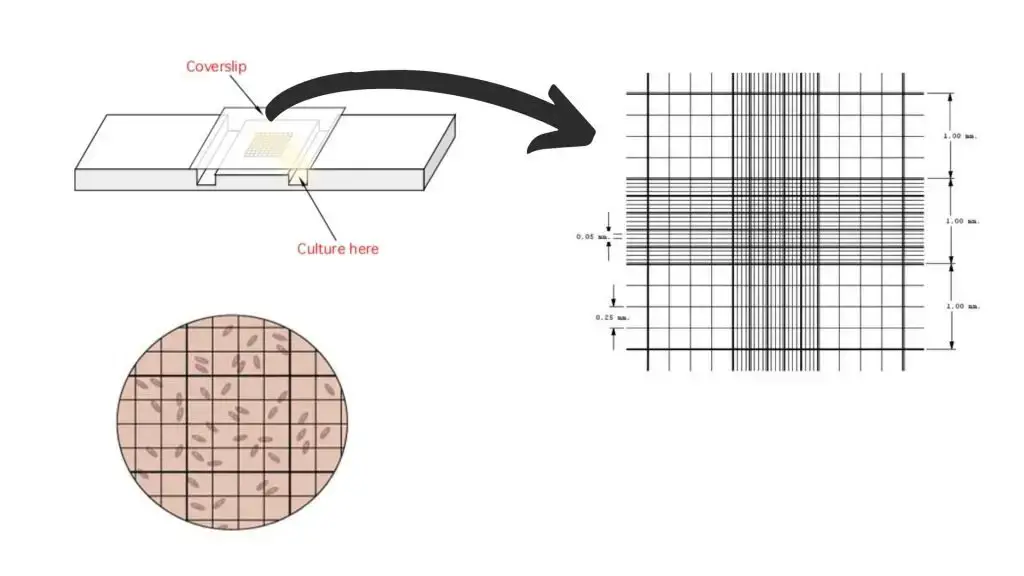Direct Microscopic Count (DMC)
- Direct Microscopic count (DMC) is a quantitative test and used to enumerate the number of bacterial clumps or somatic cells present in milk.
- This method is also used for the analysis of foods, water, and, in some cases, air for quantitative counting of microorganisms.
- There are present several steps to accomplish this method, such as direct microscopic counts, use of an electronic cell counter such as the Coulter Counter, chemical methods for estimating cell mass or cellular constituents, turbidimetric measurements for increases in cell mass, and the serial dilution–agar plate method.
- For DMC a special slide is used called Petroff-Hausser counting chambers, which consists of a ruled slide and a coverslip.
- It contains many aliquots of known volume, during the enumeration process the number of bacterial cells in a single aliquot is counted by using a microscope, and then the total number of cells is determined by mathematically.
- This Counting Chamber is designed to count bacteria, sperm, and blood platelets.
- The rulings cover 9 square millimeters, and boundary lines of the Neubauer ruling are the center lines of the groups of three.
- The central square millimeter of this Counting Chamber is ruled into 25 groups of 16 small squares, a triple line separating each group, and the middle line is a boundary.
- The dominated floor is 0.02 mm under the cover glass, which makes the amount over an sq. millimeter 0.02 mm3 (cubic mm). All cells are counted on this sq. millimeter.

Cell Counting Formula In Counting Chamber
The number of bacterial cell per milliliter (ml) = Number of cells counted X dilution (if used) X 50,000*
The factor of 50,000 is used in order to determine the cell count for 1 ml: 1 ml = 1000 mm3 = (50 times the chamber depth of 0.02 mm) * 1000.
Advantage of Direct Microscopic Count
- Rapid, Simple and easy method.
- Require less time to perform.
- A large number of samples can be screened in a given period of time.
- Useful in providing the estimated counts, types of bacteria and somatic cells in milk.
- Required minimum equipment.
- The Morphological structure of the bacterial cell can be observed during counting.
- It is possible to count very dense suspensions if they are diluted appropriately.
Disadvantage of Direct Microscopic Count
- This test is not reliable, because it does not differentiate between dead cells and live calls.
- This technique is not suitable for pasteurized milk
- Small cells are not clearly visualized under the microscope.
- Precision is difficult to achieve.
- Required a phase-contrast microscope, when the sample is not stained.
- cell suspensions of Low-density can not be observed by using this method.
FAQ on Direct Microscopic Count
Which stain is used in direct microscopic count?
During direct microscopic count Newman’s stain is used to stain the smear.
How do you count bacteria under a microscope?
We can count bacterial cell under microscope by using Petroff-Hausser counting chambers.
What is the primary and secondary purpose of Direct Microscopic Count?
The primary purpose of a direct microscopic examination (wet mount) is to determine whether or not mold is growing on the surface sampled, and if so, what kinds of molds are present.
The secondary purpose is Most surfaces collect a mix of spores which are normally present in the environment.
Reference
- http://textbookofbacteriology.net/growth_2.html
- http://repository.uobabylon.edu.iq/mirror/resources/paper_2_13669_749.pd
- https://www.emsdiasum.com/microscopy/technical/datasheet/63512-20.aspx
- http://ecoursesonline.iasri.res.in/mod/resource/view.php?id=101513
- https://ajph.aphapublications.org/doi/10.2105/9780875530024ch10
- Text Highlighting: Select any text in the post content to highlight it
- Text Annotation: Select text and add comments with annotations
- Comment Management: Edit or delete your own comments
- Highlight Management: Remove your own highlights
How to use: Simply select any text in the post content above, and you'll see annotation options. Login here or create an account to get started.